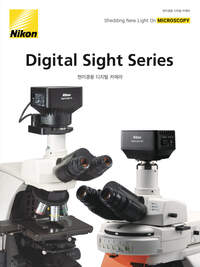- ko Change Region
- Global Site
저조도 형광과 넓은 시야를 캡처하세요.
현미경 검사에 최적화된 니콘 디지털 SLR 카메라 FX 포맷 CMOS 센서가 탑재된 DS-Qi2는 고화소 밀도, 고감도, 저노이즈의 초고화질 16.25메가픽셀 흑백 카메라로 정량 형광 이미징 분야에 탁월한 선택입니다.
* DS-Qi2는 임상 진단용이 아닙니다.
주요 특징들
대형 포맷 CMOS센서
니콘은 현미경 검사에 최적화된 전문가용 D-SLR 카메라용 CMOS 센서가 이미징 기술을 제조합니다.
고감도
희미한 형광 신호도 감지합니다.
7.3μm 화소, 높은 양자 효율, 매우 낮은 판독 노이즈 덕분에 DS-Qi2는 희미한 형광 신호도 판독할 수 있습니다.
뛰어난 선형성
신뢰할 수 있는 정량 분석 가능
선형성 오차가 ±1%인 DS-Qi2는 시간 기반 강도 측정 및 비율 측정을 포함하여 형광 시료의 강도를 측정하는 데 탁월한 도구입니다.
낮은 노이즈
초저노이즈의 희미한 형광 신호 포착
2.2 전자는 노이즈를 판독하며, 이는 대용량 풀웰 용량과 결합되어 노이즈가 매우 적고 다이내믹 레인지가 매우 높은 형광 이미지를 획득할 수 있습니다.
낮은 노이즈로 GFP-EB3 튜불린을 발현하는 LLC-PK1 세포. 선형 전체 웰 용량이 커서 한 번의 캡처로 가장 밝은 영역과 가장 어두운 영역을 모두 확보할 수 있습니다.
캡처한 이미지에는 가장 밝은 영역과 가장 어두운 영역을 모두 표시하도록 강도가 조정된 이미지가 표시됩니다.
샘플 제공: Michael Davidson, National High Magnetic Field Laboratory, Florida State University
타임랩스 사진
NIS-Elements 소프트웨어와의 통합을 통한 형광 타임랩스 이미징
넓은 시야각과 화소 밀도, 낮은 노이즈를 갖춘 DS-Qi2는 시간 분해능이 뛰어난 이미징 애플리케이션에 이상적입니다.
GFP-EB3 튜불린이 있는 LLC-PK1 세포의 타임랩스 이미지(1초마다). 각 이미지는 타임랩스의 최대 강도 투영을 나타내며, 미세소관 플러스-엔드에 위치한 말단 결합 단백질을 시각화하고 미세소관 경로를 추적할 수 있게 해줍니다.
DS-Qi2는 매우 넓은 시야각을 캡처하지만, 큰 FOV 이미지에서 잘라낸 이 타임랩스 시퀀스에서 볼 수 있듯이 매우 세밀한 디테일을 표현합니다.
대물 렌즈: CFI Plan Apochromat Lambda 60X Oil / NA: 1.4)
샘플 제공: Michael Davidson, National High Magnetic Field Laboratory, Florida State University


